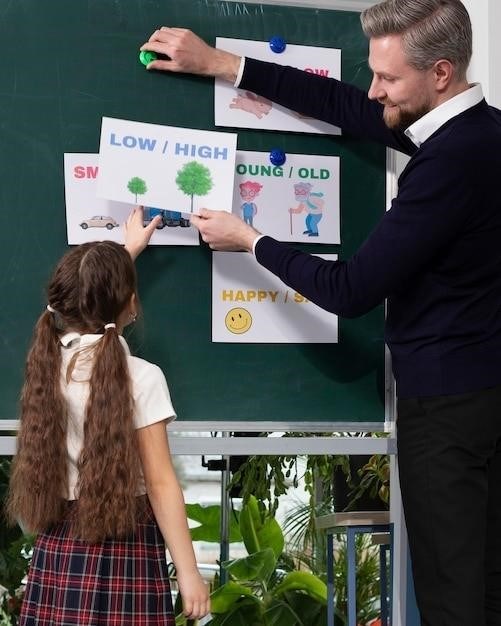Interactive Tutorial⁚ Superlatives
Welcome to our interactive tutorial on superlatives! This guide will explore the fascinating world of superlatives, helping you understand their function, formation, and usage in sentences. Through engaging activities and interactive exercises, you’ll learn how to confidently use superlatives to express the highest or lowest degree of a quality in your writing and speech. Join us on this exciting journey of grammatical mastery, and discover the power of superlatives to elevate your communication skills.
Introduction to Superlatives
In the realm of grammar, superlatives play a crucial role in expressing the highest or lowest degree of a quality. They allow us to compare and contrast, highlighting the most or least prominent aspect of something. Imagine a group of friends, each with their own unique qualities. Superlatives help us identify the tallest, the funniest, or the most adventurous among them. They provide a means of emphasizing extremes and conveying a sense of distinction.
Superlatives are often used to describe the most exceptional or remarkable instance of a quality. They can be applied to adjectives, adverbs, and even nouns, adding a layer of intensity to our language. For instance, “the tallest building” or “the most delicious cake” highlight the exceptional nature of the subject being described. Understanding superlatives allows us to articulate our thoughts with precision and clarity, making our communication richer and more impactful.
This interactive tutorial aims to demystify the concept of superlatives, equipping you with the knowledge and skills to confidently use them in your daily life. Through engaging examples, interactive exercises, and step-by-step explanations, we’ll explore the various aspects of superlatives, from their formation to their applications in diverse contexts. Get ready to embark on an exciting journey into the world of superlatives and master the art of expressing extremes with confidence.
The Function of Superlatives
Superlatives serve a vital function in language by providing a means to compare and contrast, highlighting the most or least prominent aspect of something. They allow us to express extremes, conveying a sense of distinction and emphasizing the exceptional nature of a quality. When we use superlatives, we’re not simply describing something; we’re highlighting its unique position in relation to others.
Think of it like a competition where the superlative acts as the trophy, awarded to the winner. For example, saying “the tallest building” implies a comparison with other buildings, recognizing its superior height. Superlatives add a layer of intensity to our language, making our descriptions more vivid and impactful. They allow us to communicate our thoughts with precision and clarity, emphasizing the most significant or remarkable aspect of a subject.
Beyond simple comparisons, superlatives can also evoke emotions and create a sense of awe or wonder. For instance, describing a sunset as “the most beautiful” can evoke a feeling of admiration and appreciation. Superlatives are essential tools for enhancing our communication, allowing us to express ourselves with greater nuance and impact. Their ability to highlight extremes and convey a sense of distinction makes them indispensable elements of effective language use.
Forming Superlatives
Forming superlatives in English involves adding specific suffixes or using irregular forms, depending on the adjective or adverb. For one-syllable adjectives, we typically add “-est” to the end, such as “tall” becoming “tallest”. Two-syllable adjectives ending in “-y” usually change the “y” to “i” and add “-est”, like “happy” becoming “happiest”. However, for two-syllable adjectives not ending in “-y” or for adjectives with more than two syllables, we use “most” before the adjective, like “beautiful” becoming “most beautiful”.
Adverbs often follow the same rules as adjectives, with “-est” added for one-syllable adverbs or “most” used for longer adverbs. For example, “fast” becomes “fastest” and “quickly” becomes “most quickly”. However, it’s important to remember that some words have irregular superlative forms, such as “good” becoming “best” and “bad” becoming “worst”. These irregular forms are exceptions to the general rules and must be learned individually.
Understanding the rules for forming superlatives is crucial for using them accurately and confidently. By mastering these rules, you can effectively communicate the highest or lowest degree of a quality, enhancing your writing and speech with precision and clarity. Remember to practice these rules and familiarize yourself with the irregular forms, as they are essential for mastering superlatives and expressing yourself with greater sophistication.
Superlative Adjectives
Superlative adjectives are powerful tools for emphasizing the highest or lowest degree of a quality within a group of three or more. They highlight the most extreme or exceptional characteristic, providing a clear and impactful description. For example, “tallest” signifies the greatest height among a group, while “smallest” indicates the least size. Superlative adjectives are frequently used in comparative statements, emphasizing the outstanding quality of a particular person or thing.
To form superlative adjectives, we generally follow the rules outlined in the “Forming Superlatives” section. For one-syllable adjectives, we add “-est” (e.g., “tallest”), while for two-syllable adjectives ending in “-y”, we change the “y” to “i” and add “-est” (e.g., “happiest”). For longer adjectives or two-syllable adjectives not ending in “-y”, we use “most” before the adjective (e.g., “most beautiful”). However, remember that some adjectives have irregular superlative forms, such as “best” for “good” and “worst” for “bad”.
Superlative adjectives are versatile and essential for crafting vivid and expressive language. By strategically incorporating them into your writing and speech, you can effectively communicate the most remarkable qualities, leaving a lasting impression on your audience.
Superlative Adverbs
Superlative adverbs are the ultimate degree of comparison, signifying the most extreme or least extreme manner in which an action is performed. They add a powerful touch to sentences, emphasizing the intensity or degree of an action. While adjectives describe nouns, adverbs modify verbs, adjectives, or other adverbs, providing a nuanced understanding of how something is done.
For instance, “most quickly” denotes the fastest speed of movement, while “least carefully” suggests the lowest level of attention to detail. Superlative adverbs are essential for creating vivid descriptions and effectively conveying the intensity of actions. They paint a picture of how something is done, highlighting the most extreme or least extreme aspect of the action.
Forming superlative adverbs generally follows the same rules as forming superlative adjectives. For one-syllable adverbs, we add “-est” (e.g., “fastest”). For longer adverbs or those ending in “-ly”, we use “most” before the adverb (e.g., “most carefully”). However, some adverbs have irregular superlative forms, such as “best” for “well” and “worst” for “badly”. By understanding and utilizing superlative adverbs, you can add depth and clarity to your writing and speech.
Irregular Superlatives
While the rules for forming regular superlatives are generally straightforward, the English language is known for its quirks and exceptions. This is where irregular superlatives come into play, presenting unique challenges and enriching the language’s diversity. These words don’t follow the typical “-est” or “most” pattern, instead relying on their own established forms.
Some common examples include “best” (from “good”), “worst” (from “bad”), “least” (from “little”), “most” (from “much”), “farthest” (from “far”), “furthest” (from “far”), and “latest” (from “late”). These irregular superlatives have become ingrained in the language through usage and convention, and they add a layer of complexity and memorization to mastering the nuances of English grammar.
Learning these irregular forms is crucial for accurate and fluent communication. They are frequently encountered in everyday speech and writing, and their correct usage demonstrates a refined understanding of the language. Understanding irregular superlatives adds a layer of sophistication to your vocabulary and allows you to express yourself with greater precision and confidence.
Using Superlatives in Sentences
Superlatives are powerful tools for expressing the highest or lowest degree of a quality when comparing three or more items. They add emphasis and precision to your sentences, making your writing or speech more vivid and impactful. To use superlatives effectively, you need to understand their placement and the grammatical structures that accompany them.
Superlative adjectives usually precede the noun they modify, often accompanied by the definite article “the.” For example, “the tallest building,” “the most expensive car,” or “the least interesting book.” Superlative adverbs, however, modify verbs, adjectives, or other adverbs, and they typically appear before the word they modify. For instance, “He ran fastest,” “She is most beautiful,” or “I waited longest.”
When constructing sentences with superlatives, it’s crucial to ensure the comparison is clear and unambiguous. The context should make it evident which group or category is being compared. For example, “This is the best restaurant in town” implies a comparison among all restaurants in that specific town. Using superlatives effectively requires a conscious effort to choose the right words and structures to convey your intended meaning accurately and engagingly.
Interactive Activities
Learning superlatives can be fun and engaging! We’ve designed a series of interactive activities to reinforce your understanding and help you practice using superlatives in different contexts. These activities are designed to be both challenging and rewarding, encouraging you to apply your knowledge while having fun.
Get ready to test your skills with interactive games that involve matching superlative forms with their corresponding adjectives or adverbs, creating sentences using superlatives, and identifying the correct superlative form in a given context. We’ll also provide you with interactive worksheets that allow you to practice forming superlatives and using them in various sentence structures.
The activities are designed to be user-friendly and adaptable to different learning styles. You can choose to work independently or collaborate with others, making the learning process more dynamic and enjoyable. These interactive activities are an excellent way to solidify your grasp of superlatives, making them a natural part of your linguistic repertoire.
Superlative Games
Superlative games are an engaging and effective way to practice and solidify your understanding of superlatives. These games transform grammar learning into a fun and interactive experience, making it more enjoyable and memorable. We’ve curated a collection of superlative games designed to challenge your knowledge and reinforce your skills in a playful environment.
Get ready to engage in exciting games that require you to create superlative sentences, identify the correct superlative forms, and use your knowledge to solve puzzles and challenges. You can participate in these games individually or as part of a team, fostering collaboration and friendly competition.
These games are designed to be versatile and adaptable to different learning levels. Whether you’re a beginner or an advanced learner, you’ll find engaging activities that cater to your needs and learning style. Through these interactive games, you’ll develop a deeper understanding of superlatives, making them an essential part of your grammatical toolkit.
Superlative Worksheets

Superlative worksheets provide a structured and focused approach to practicing your superlative skills. These worksheets offer a variety of exercises designed to reinforce your understanding of superlative formation, usage, and application in different contexts. Through these exercises, you’ll gain confidence in identifying and using superlatives correctly, improving your overall grammatical accuracy.
Our superlative worksheets are tailored to cater to different learning styles and preferences. You can choose from a wide range of exercises, including filling in the blanks, matching superlative forms, constructing superlative sentences, and identifying errors in superlative usage. These exercises are designed to be challenging yet engaging, ensuring a comprehensive and effective learning experience.
Each worksheet includes clear instructions and examples to guide you through the exercises. Additionally, answer keys are provided for self-assessment and to help you identify areas where you need further practice. By completing these worksheets, you’ll gain a solid foundation in superlatives, enabling you to confidently express the highest or lowest degree of a quality in your writing and speech.

Superlative Quizzes
Superlative quizzes are a dynamic and interactive way to test your understanding of superlatives and evaluate your progress. These quizzes provide a fun and engaging way to reinforce your knowledge of superlative formation, usage, and application in various contexts. They offer a challenging yet rewarding experience, allowing you to track your learning journey and identify areas where you need further practice.
Our superlative quizzes are carefully crafted to assess different aspects of superlative usage. They include a variety of question formats, such as multiple-choice, true or false, fill-in-the-blanks, and sentence construction. These quizzes are designed to challenge your understanding of superlative rules and encourage you to apply your knowledge in practical situations.
Each quiz provides immediate feedback and detailed explanations for correct and incorrect answers. This feature allows you to learn from your mistakes and improve your understanding of superlatives. The quizzes are also timed, adding an element of excitement and encouraging you to focus and work efficiently. By completing these quizzes, you’ll gain a deeper understanding of superlatives and improve your overall grammatical proficiency.
Superlative Flashcards
Superlative flashcards are a versatile and engaging tool for mastering the intricacies of superlatives. These flashcards offer a visually appealing and interactive way to learn and memorize the rules, forms, and applications of superlatives. They provide a structured and focused learning experience, allowing you to reinforce your knowledge and build confidence in using superlatives correctly.
Each superlative flashcard typically features a word or phrase on one side, showcasing the superlative form of an adjective or adverb. The other side provides the definition, examples of usage, and relevant grammatical rules. This format allows you to quickly review and recall the key concepts associated with superlatives, promoting active learning and retention;
Superlative flashcards can be used independently or in a group setting. You can test yourself by flipping through the cards, trying to recall the superlative form or its meaning. Alternatively, you can use them with a partner, taking turns quizzing each other or playing games to make learning more interactive and enjoyable. With regular practice using superlative flashcards, you’ll gain a solid grasp of superlatives and confidently incorporate them into your written and spoken communication.
Mastering Superlatives
As you conclude this interactive tutorial on superlatives, you’ve gained valuable insights into the world of expressing the highest or lowest degree of qualities. You’ve explored the function of superlatives, delved into their formation, and practiced using them in sentences. Through engaging activities and interactive exercises, you’ve honed your understanding and strengthened your ability to confidently use superlatives.
Remember, mastering superlatives isn’t about memorizing complex rules but about understanding their essence and applying them effectively. Superlatives add depth, precision, and emphasis to your language, allowing you to express your thoughts and ideas with greater clarity and impact. As you continue to practice and refine your skills, you’ll discover the power of superlatives to enhance your communication and make your writing and speech more engaging and impactful.
Embrace the knowledge you’ve gained and use it to elevate your writing and speech. Remember, superlatives are a powerful tool for expressing the highest or lowest degree of qualities. By confidently incorporating them into your communication, you’ll enhance your linguistic prowess and convey your thoughts with greater precision and impact.



